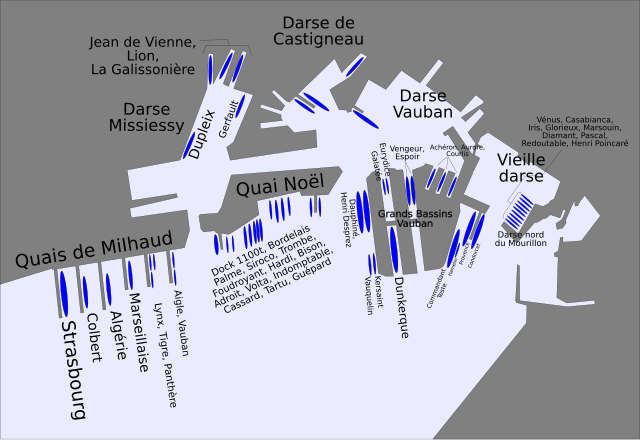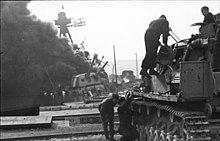Self-sinking of the Vichy fleet

The self-sinking of the Vichy fleet occurred on November 27, 1942 in Toulon . By order of the admiralty of the French Vichy regime , its Mediterranean fleet was sunk in the port of Toulon in order to withdraw it from the grip of Germany , but also the Allies .
prehistory
After the defeat in 1940 , France was divided into two zones in the Compiègne armistice on June 22, 1940; the southeastern part of the country was left to the authoritarian Vichy regime under Marshal Henri Philippe Pétain . This partially cooperated with Germany, whereas its relations with the Allies were complex: While British troops attacked and sank part of the French fleet in Operation Catapult as early as 1940 , the USA granted Vichy-France diplomatic recognition. When the Allies began the invasion of North Africa in 1942 , they cooperated with some Vichy generals .
As a result, on the orders of Adolf Hitler , Vichy France was occupied by German troops from November 11, 1942 under the code name Company Anton . While negotiations were still taking place over the status of Toulon, Hitler had Operation Lila prepared from November 19 ; while Toulon and the fleet lying there were to be occupied by German troops and the latter were to be handed over to fascist Italy. At the same time, the French admiral Gabriel Auphan ordered that the fleet be sunk in such a case.
procedure
The German company Lila began on the morning of November 27, 1942. At 4:30 am, German troops occupied Fort Lamargue and the French arsenals and coastal batteries . German ships crossed in front of the port entrance and laid sea mines to prevent the fleet from escaping. Admiral André Marquis was captured. Thereupon Admiral Jean de Laborde gave the order from on board the French flagship Strasbourg to prepare for the sinking of the fleet and to fire on intruders without warning. The French managed to hold off the main German force for almost an hour. When it crossed the main gate of the naval base at 5:25 a.m., the instructions for implementation were finally transmitted. The crews then disembarked their ships. Then the sinking teams began to detonate attached charges and let water into the ships.

The German venture was an almost complete failure. The feared Allied attack could be prevented, but the French sank and destroyed three of their battleships (the Provence , as the last unit of the Bretagne class in their possession, the Strasbourg and Dunkerque of the Dunkerque class ), seven cruisers , fifteen destroyers, twelve submarines and 74 other ships and boats. None of them remained in a condition that would have enabled immediate recovery, larger units burned for weeks. Only 39 militarily worthless and smaller ships and boats were captured by the Germans, most of them had previously been sabotaged and disarmed. Twelve French seamen were killed and 26 wounded.
Recessed units (selection)
The Italian Regia Marina was able to take over 3 light cruisers, 11 destroyers, 11 smaller ships and boats, 9 submarines and 10 demining vehicles, not all of which survived the war.
Battleships
- Dunkerque , Strasbourg (flagship of the Admiral) of the Dunkerque class
- Provence of Brittany class ( Dreadnoughts the First World War)
The Provence was on 11 July 1943 by the Germans, who Strasbourg rescued by the Italians on 17 July 1943rd The capital ships were still the target of air strikes and could no longer move. Four of the main guns of Provence were built into a coastal fortification at Saint-Mandrier-sur-Mer ; with their range the entrance to the port of Toulon could be controlled. After D-Day 1944 the ship was sunk again as a block ship, lifted and scrapped in April 1949.
Aircraft mother ship
The aircraft mothership Commandant Teste was brought up by the Italians on May 1, 1943. It was handed over to the Germans four months later and sunk by US bombers on August 19, 1944. The Americans made the tests buoyant in February 1945 and prepared them for restarting, but this was abandoned after the end of the war.
Heavy cruisers
- Algérie
- Dupleix , Foch , Colbert of the Suffren class
Parts of the Algérie were salvaged from the heavy cruisers on March 18, 1943 , but were not reactivated. The ship was bombed by the Allies and sank again on March 7, 1944. The heavy cruisers Foch and Dupleix swam on April 16 and again on July 3, 1943, Colbert was too badly damaged. Dupleix was classified as a training ship FR14 , sunk on March 11, 1944 by bombs . Foch was towed to La Seyne-sur-Mer , demolished there from 1943, Colbert after the war in Toulon.
Light cruisers
Of the light cruisers, the lead ship and Jean de Vienne were lifted by the Italians on February 18 and March 3, 1943, respectively, and provisionally put into service as FR11 and FR12 ; La Marseillaise was dispensed with. La Galissonnière capsized after a US bomber attack on August 18, 1944.
Large Destroyer (Contre-Torpilleurs)
- Mogador and Volta of the Mogador class
- L'Indomptable of the Le Fantasque class
- Vauquelin , Cassard , Kersaint and Tartu of the Vauquelin class
- Aigle , Gerfaut and Vautour of the Aigle class
- Guépard , Lion , Valmy , Vauban and Verdun of the Guépard class
- Lynx , Panthère and Tigre of the Chacal class
Destroyers (Torpilleurs)
- Le Hardi , L'Adroit , Bison , Casque , Foudroyant , Lansequenet , Mamelouk , Siroco of the Le Hardi class
- Bordelais , Le Mars , La Palme of the L'Adroit class
- Trombe the Bourrasque class
Torpedo boats
- Bayonnaise , Poursuivante , Baliste of La Melpomène class
Avisos , mine layers
- D'Iberville of the Bougainville class
- Impétueuse , Curieuse of Elan class
Gunboats , mine clearance boats
- Yser of the Somme class
- Dédaigneuse of the Ardent class
- Granite , Épargne
- Chamois of Chamois class
Submarines
Class 1, ocean-going boats :
- Caïman the Requin class - Marsouin escaped with escape attempt
of which boats of the 1500 tonne type:
- Casabianca of the Agosta class - escaped
- L'Espoire 's L'Espoire class - Le Glorieux escaped
- Redoutable , Achéron , Fresnel , Henri Poincaré , Pascal , Vengeur of the Redoutable class
Class 2, Coastal Defense :
- Vénus of the Minerve class , Iris escaped
- Aurore of the Aurore class
of which boats of the 600 ton type:
- Thétis of the Circé class
- Eurydice the Ariane-Class
- Sirène , Naïade , Galatée of the Sirène class
Class 3, minelayer :
- Diamond of sapphire-Class
Attempted escape
A few crews ignored the order to sink, attempted to escape and wanted to move to the departments in North Africa, which were still administered by Vichy France . Of the 1500-ton submarines , the Casabianca of the Agosta class and Le Glorieux of the L'Espoire class were successful and reached Algiers and Oran, respectively . The Marsouin of the Requin class and the barrel boy Leonor Fresnel also arrived in Algiers. Of the two boats of the Minerve class, the Vénus failed and was sunk by the crew at the port entrance, while the Iris stopped at Barcelona in neutral Spain due to a lack of fuel and was interned there.
The remnants of the fleet in Toulon were not reactivated after the war and were scrapped from the end of the 1940s until the 1950s.
See also
literature
- Hannsjörg Kowark : The end of the French fleet in World War II. Toulon 1940-1944 . Hamburg 1998. ISBN 3-8132-0548-7 .
- Reinhard Stumpf : The war in the Mediterranean region 1942/43 - The operations in North Africa and in the central Mediterranean. In: The German Reich and the Second World War . Volume 6. Ed. Military History Research Office , Deutsche Verlags-Anstalt , Stuttgart 1990, ISBN 3-421-06233-1 , pp. 569-757.
Web links
- NetMarine.net , Sabordage de la Flotte (French) - Overview of the events
- Battleships-Cruisers.co.uk , Scuttling at Toulon - overview and photographs
Footnotes
- ↑ NetMarine.net , listing of the units at their berths on the morning of November 27, 1942 (French)
- ^ RegiaMarina.net , Pierluigi Malvezzi: "Foreign-built"; List of foreign units of the Italian Navy in World War II (ital.)




